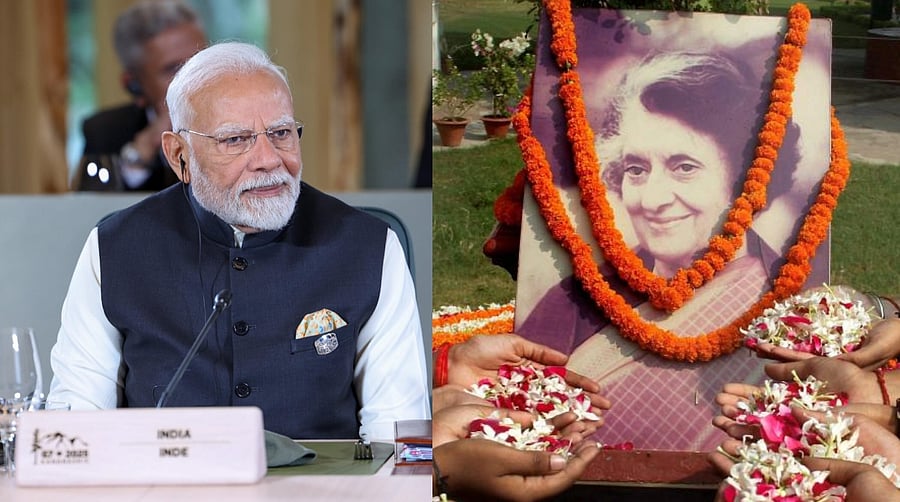
PM Narendra Modi (L); A picture of former PM Indira Gandhi (R).
Credit: PTI Photos
Fifty years after the imposition of Emergency by Indira Gandhi, on June 25, 1975, it would be shortsighted to frame it solely as the beginning of a ‘dark chapter’ in India’s history when democracy was throttled.
True, that severe curtailment of fundamental rights of citizens, throttling of the rule of law, and imprisonment of innumerable political opponents during the 21-month period were unquestionably condemnable.
However, while reflecting on the past, it is necessary to assess the entire period beginning with events which catalysed Gandhi’s decision, continuing through the 1977 Lok Sabha elections, and subsequent formation of India’s first non-Congress coalition government at the national level, to the Janata Party’s collapse, and her return to power in January 1980, as a major transitional phase of Indian politics.
Additionally, the Sangh parivar succeeded in mainstreaming itself and securing ‘political legitimacy’, if not for the Rashtriya Swayamsevak Sangh (RSS) directly, but at least for its political offshoot, the Bharatiya Jana Sangh.
Furthermore, can imposition of Emergency and recapitulation of the months till March 1977, during which every conceivable state institution was also virtually strangulated, be recalled without taking stock of extent to which the current political regime is unwilling to tolerate dissent, and allow various branches of the State and other autonomous to function as the Constitution spells?
In recent years, every anniversary of Emergency has been used by the Bharatiya Janata Party (BJP) leaders as an occasion to verbally flog the Congress. Last year too, barely 20 days after it was declared that the people of India denied Prime Minister Narendra Modi a clear majority in the Lok Sabha, he berated the Congress while raking up the historicity of events surrounding June 25, 1975.
But, even while Modi asserted that Emergency was a “black spot on the Constitution” of India, the Opposition I.N.D.I.A. bloc leaders, including Congress’ Mallikarjun Kharge and Rahul Gandhi, waved copies of the Constitution back at Modi.
Modi knew why the text he famously termed in 2014 after being elected to power as the country’s “only Holy Book” was waved at him mockingly. After all, among various factors that resulted in electoral setbacks for the BJP, the impression that Modi would ‘change’ the Constitution gained currency courtesy smart campaigning by several Opposition leaders. Despite this, the Union government went ahead and decided to observe every June 25 as 'Samvidhaan Hatya Diwas' (Constitution Murder Day).
Clearly, the current government pays lip service to the Constitution even while it has made several fundamental changes, including making the grant of Indian citizenship dependent on the applicant’s religious identity.
Yet, there is no denying that there can be little but condemnation for Indira Gandhi and her decision to suspend fundamental rights even as she dispatched the police at midnight to knock on the doors of political opponents and haul them up in jail.
Among her many acts during those grim months was also the enactment of omnibus 42nd Amendment Act in November 1976. Often dubbed as a veritable ‘mini-Constitution’ because of wide-ranging changes in the original document, one of its objectives was to centralise power and reduce judicial oversight. In hindsight, it is evident that Indira Gandhi erred in making her intentions too obvious — power could always be consolidated and its controls handed over to a single individual more subtly, without constitutional amendment.
Indira Gandhi’s panic-stricken decision to impose Emergency despite securing a partially favourable judgment from the Supreme Court’s solitary vacation judge, Justice V R Krishna Iyer, meant that she morally accepted ‘defeat’ with the verdict of Justice Jagmohan Lal Sinha. Several Opposition leaders had been agitating in tandem since early 1974 in various parts of India, most notably in Gujarat and Bihar, and mobilised on Jaya Prakash Narayan’s call for ‘Total Revolution’. But, Indira Gandhi’s decision to arrest them ensured that once she called for parliamentary elections in early 1975 and released detained leaders, they decided to convert the amorphous entity into an impromptu political party. It had no ideological cohesion, and was merely driven by the goal to vote Gandhi out of power.
The failure of the Janata experiment eventually paved the way for more coherent coalitions, although several parties continued merging into parties with new nomenclature and presiding ideological deities. Significantly, the Jana Sangh, despite being part of Samyukt Vidhayak Dal coalition governments in several states in north and central India in 1967-1968, was mainly treated like a pariah, chiefly for its links with RSS, still accused by its critics of being a part of the conspiracy to assassinate Mahatma Gandhi.
Eventually, through the Nav Nirman movement in Gujarat and agitations in other north Indian states, Narayan realised that there were benefits of aligning with the RSS and its network of grassroot workers. Contentiously, at a Jana Sangh executive meeting in March 1975 in Delhi, Nayaran declared, “If you are fascist, then I too am a fascist.”
The embrace done, it was just a matter of time before RSS pracharaks of one time would become ministers, and Atal Bihari Vajpayee and Lal Krishna Advani became the foreign and information and broadcasting ministers respectively. After gaining credibility, Advani felt he had the moral right to proclaim judgements on others, a habit which continued till he remained politically active. But, one of those needs to be recalled as we mark 50 years of imposition of Emergency, a period when the bulk of the Indian media acquiesced to State-imposed censorship. Advani had quipped that journalists “were asked to bend but they crawled.” His words haunt us in today’s era of media-led jingoism, tragically presented as nationalism.
Nilanjan Mukhopadhyay, a Delhi-based journalist, is author of 'The Demolition, The Verdict and The Temple: The Definitive Book on the Ram Mandir Project'. X: @NilanjanUdwin.
Disclaimer: The views expressed above are the author's own. They do not necessarily reflect the views of DH.